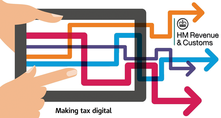 Photo by Kelly Sikkema on Unsplash | The Chancellor delivered his Autumn Statement this week. Many of the measures announced were given much advance coverage and in one or two cases were not as tight as many had predicted. In this latest blog I've covered the major points of interest for my followers and readers to make sure you get the information you might need. It's in manageable portions and in plain language to make things easier to follow |
|
0 Comments
 Courtesy of HMRC Courtesy of HMRC Over the summer HMRC published some changes to Making Tax Digital which have ben warmly received by the businesses and professionals. The government has said it believes that introducing a new digital tax system is still the right direction to move in. However, it has made amendments to the businesses this impacts and the timescales for change. The amendments to Making Tax Digital now mean:
 Photo by Sharon McCutcheon on Unsplash Photo by Sharon McCutcheon on Unsplash This is an area which can cause problems for owners of small limited companies. With the arrival of the dividend tax it’s becoming increasingly important to document, declare and pay dividends correctly as the timing of these can influence your (and other shareholders’) tax bills. I might have mentioned before but it really is unacceptable to simply take ‘drawings’ and hope it levels out at the year end! Recently I’ve been prompted to compose a blog post about the service I provide to the County. To say that I was prompted is an understatement. I was press ganged into writing this by two regular clients who you’ll hear from later. So… let’s do this then…
 Photo by Kelly Sikkema on Unsplash Photo by Kelly Sikkema on Unsplash Inheritance Tax (IHT) is a tax on the estate of someone who’s died – the rate can be as high as 40%. We each have a ‘nil rate band’ of £325,000. Married couples and civil partners are allowed to pass their estate to their spouse tax-free when they die and IHT is payable. Spouses can also pass on their unused tax-free allowance to their surviving spouse. This combined allowance means that when she dies, her estate will only incur Inheritance Tax if it’s worth more than £650,000 (£325,000 + £325,000). From 6 April 2017, everyone has an additional £100,000 (rising to £175,000 by 2020-21) tax-free allowance to use against the value of their home. Also known as the residence nil rate band. Broadly speaking, you can only get this additional allowance if they leave your home to your children or grandchildren. This allowance can also transfer to the surviving spouse if it isn’t used up already. This means by 2020-21, a married couple could leave a combined estate of up to £1 million without incurring IHT. The small print is far more complex than this article suggests and more detail can be found on THIS LINK With new year’s resolutions not that far behind us, it might be well worth reviewing your will to ensure it can take advantage of this new relief. As always, for help and advice with your business, tax matters or any other questions, please feel free to make contact with me and see what I can do for you.  Photo by Kelly Sikkema on Unsplash Photo by Kelly Sikkema on Unsplash The flat rate was introduced to simplify accounting for smaller businesses – you simply pay a relevant proportion of your gross takings to HMRC each quarter and this varies by industry category. The highest rate is currently 14.5%. As reported late last year, life is about to become a whole lot more complicated for businesses that supply largely services of labour where goods (and we are still awaiting the precise definition) comprise:
So for example as a management consultant you invoice £100,000 per annum plus VAT of £20,000. The flat rate currently applies is 14% so you pay 14% of £120,000 to HMRC i.e. £16,800. You retain £3,200. From 1 April 2017, if you do not meet the ‘goods’ test you would pay £19,800 retaining only £200 – 16.5% is a lot less kind than it first appears. We do know that goods cannot comprise capital items, food and drink and motoring expenses. There is of course the option to revert to normal standard accounting from 1 April 2017 but that does add complication to the preparation of VAT returns. For help or advice concerning VAT and your business or any other accountancy questions you may have, why not contact me via the website? Why not watch my short video below covering the flat rate of VAT?  Photo by Micheile Henderson on Unsplash Photo by Micheile Henderson on Unsplash For small investors the start of the new tax year heralds some good news with some new tax free allowances in addition to any ISA allowances or ISA that income that you may have. Interest: Banks and Building Societies will no longer deduct tax on your interest from 6 April 2016. Instead, you will receive your interest gross and not pay tax in certain circumstances:
Interestingly there is no ‘abatement’ of the allowance, so basically if your income is £1 over the basic rate limit, then you receive only the £500 allowance. If you receive significant interest which has previously been taxed, then you need to be prepared to pay the tax and complete a Self Assessment. Many clients may want to call me for a chat about this, or if you're busy and feel more comfortable, then contact us through the website here. |
Nigel GorskiSay it as it is and you'll never be misunderstood. Here in the Blog you'll see news posts on many topics of interest to your and your business... Archives
March 2024
Categories
All
|
Telephone: 07980 270610


 RSS Feed
RSS Feed